How to Store a Chainsaw So It Doesn’t Leak Oil
- January 29, 2024
- 2 comment
Discovering oil leaks from your chainsaw can be frustrating. It not only creates a mess but also wastes valuable oil and might signal issues with your chainsaw. In this guide, I’ll share simple chainsaw storage tips and maintenance advice to help prevent oil leaks, keep your chainsaw in top shape, and extend its life. You’ll learn how to store a chainsaw so it doesn’t leak oil, along with practical solutions for chainsaw oil leak prevention.
Understanding the Issue
Chainsaw oil leaks are common, even in high-end models. The oil, essential for smooth chainsaw operation, often seeps out during storage, causing spills and extra costs. That’s why knowing how to store a chainsaw without leaking oil is essential.
Storing a chainsaw properly goes beyond placing it in a garage or shed. It’s about ensuring your chainsaw is ready to use, leak-free, and well-maintained for next time. Almost every chainsaw user has dealt with storage oil leaks, but with the right steps, you can prevent them. Here’s a practical guide to effective chainsaw storage to keep those annoying oil leaks at bay.
Before Storing your Chainsaw
1. Empty of Oil Before Storing
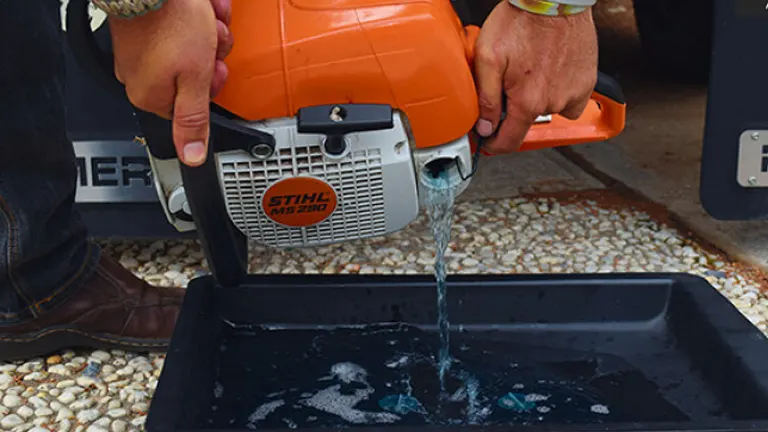
If you only use your chainsaw seasonally, like for cutting firewood in winter, it’s best to drain any leftover oil and fuel before storing it. This step helps prevent chainsaw oil leaks and protects the engine from damage caused by stagnant fluids. Proper chainsaw maintenance tips like this one ensure your chainsaw stays in top condition for when you need it next.
2. Check the Oil Line
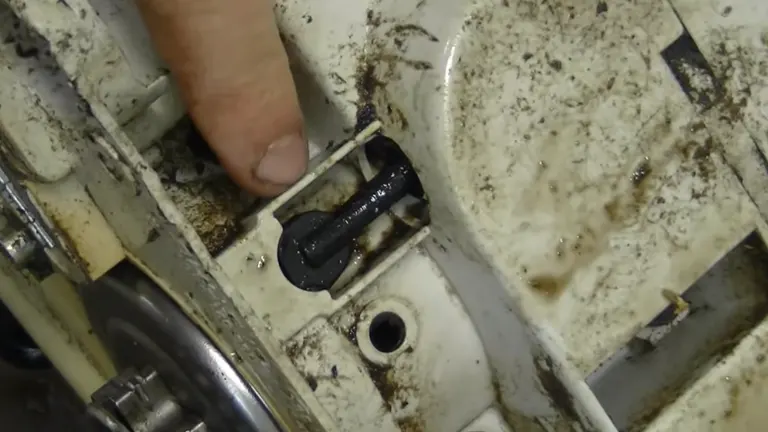
Make it a habit to inspect the oil line, which transports bar oil from the tank to the pump. Any visible leaks or cracks in this line can cause oil build-up and lead to leaks during storage. If you spot issues, replace the oil line to keep a tight, leak-proof system and stop chainsaw oil leaks before they start. This simple check is a key part of chainsaw storage solutions.
3. Don’t Overfill the Chainsaw’s Oil Storage Tank
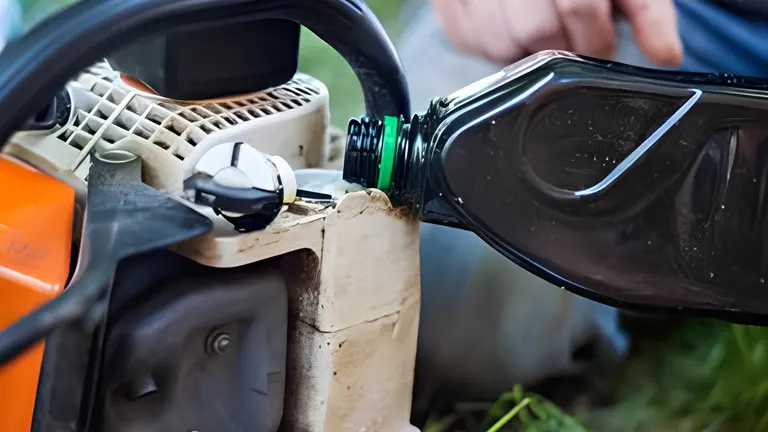
Be mindful of the oil storage tank’s capacity. Avoid overfilling, as oil expands with temperature changes. Overfilling can lead to leaks, especially in uninsulated storage areas. Aim to keep the tank no more than two-thirds full.
4. Ensure the Oil Plug is Functional
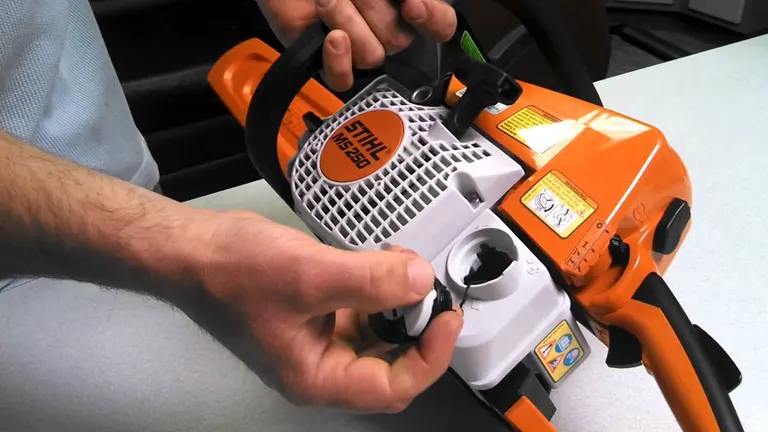
Over time, the oil plug can wear out or lose its shape, creating a weak seal that can cause leaks. To prevent chainsaw oil leaks, inspect the plug regularly and replace it if needed. Oil plugs are generally inexpensive and easy to find from your chainsaw’s manufacturer or supplier, making this a quick fix for chainsaw oil leak prevention.
5. Protect Against Leaks
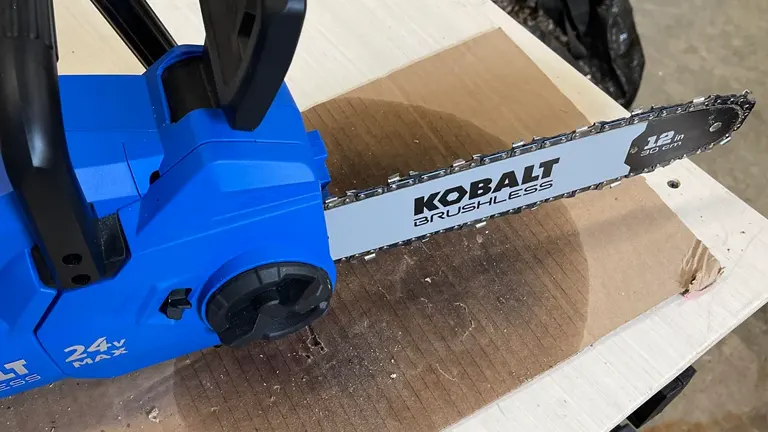
To guard against unexpected oil drips, place your chainsaw on an absorbent material, like cardboard, when storing it. This simple step helps catch any minor leaks and makes cleanup easier, adding an extra layer to your chainsaw storage solutions. It’s a practical tip for storing a chainsaw to avoid oil leaks.
Chainsaw Hanging Techniques
6. Hang the Chainsaw by Rear Handle
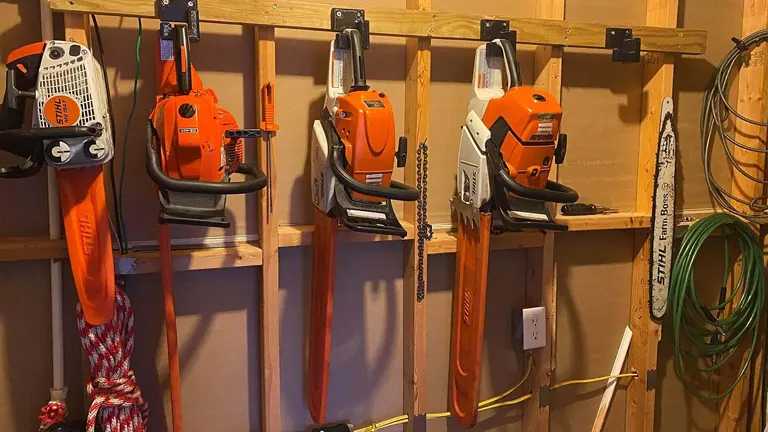
Hanging your chainsaw by its rear handle saves space and keeps it off the ground. Just be sure to drain the oil first to prevent chainsaw oil leaks while it’s stored. This method is a convenient part of chainsaw storage tips for keeping your workspace organized and leak-free.
7. Hang the Chainsaw Vertically
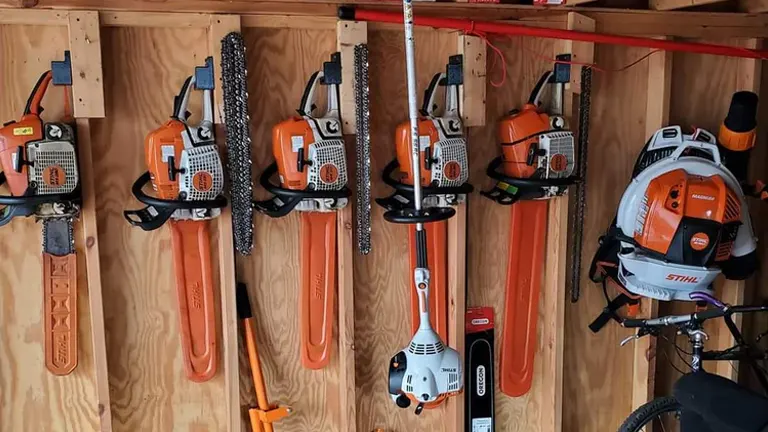
While hanging your chainsaw vertically can save space, it may cause oil leaks from pressure build-up in the tanks. To avoid this, either drain the oil before storage or “burp” the tanks to release excess pressure. These chainsaw storage tips help prevent oil leaks and keep your chainsaw in good condition.
8. Hang the Chainsaw by Brake Stop
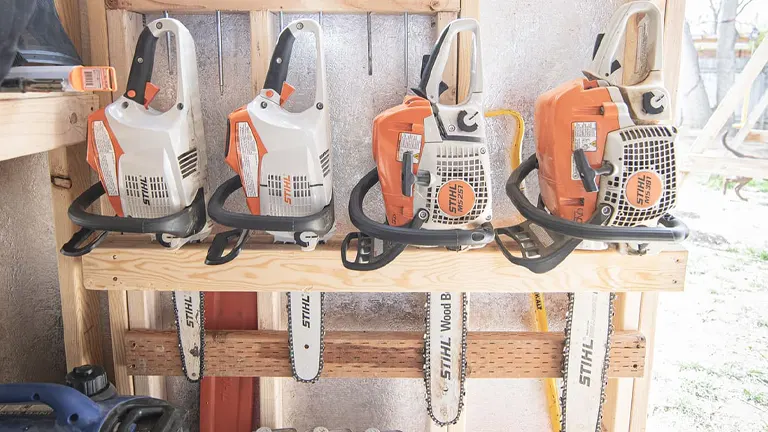
Hanging your chainsaw by the brake stop handle is an option, but it’s better suited for lighter models. Ensure the handle can support the chainsaw’s weight without strain, as this can prevent damage and reduce the chance of oil leaks. This method adds flexibility to your chainsaw storage solutions.
Maintenance and Cleaning
9. Always Keep the Outlets Clean
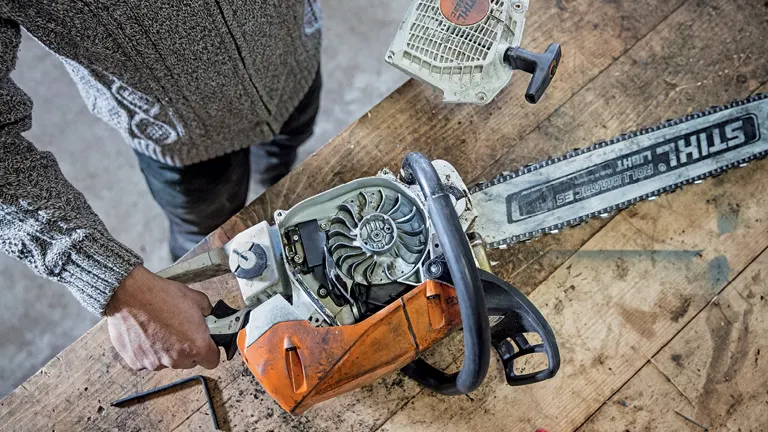
Make it a habit to clean your chainsaw’s outlets, especially if sawdust tends to build up. Clogged outlets can increase pressure in the oil system, leading to potential leaks. By keeping these outlets clear, you can help prevent chainsaw oil leaks and maintain optimal performance.
10. Never Store a Chainsaw on Its Sides
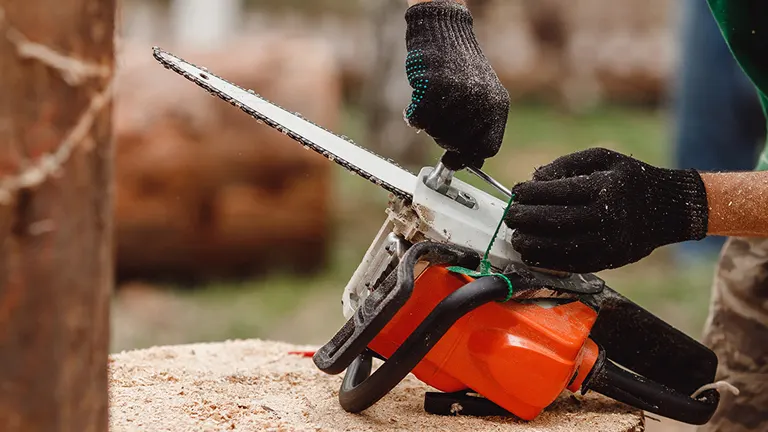
Laying a chainsaw on its side can position the oil tank openings in a way that encourages leaks. Instead, store it on a flat, stable surface, or use the hanging options described earlier to keep it leak-free. Following these chainsaw storage tips helps prevent chainsaw oil leaks and ensures your equipment is ready for use.
11. Check Your Tool for Mechanical Problems Before Storage
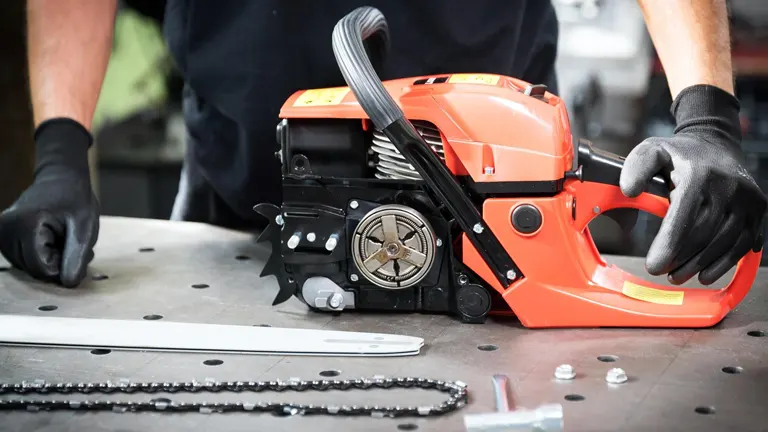
Perform a thorough check of your chainsaw for any mechanical issues before putting it in storage. Fixing potential problems in advance helps prevent chainsaw oil leaks and ensures your tool is ready to use next time. Regular maintenance like this is essential for long-term chainsaw storage solutions.
By incorporating these chainsaw storage tips into your routine, you can greatly reduce the chances of oil leaks. These practices not only keep your storage area clean but also help maintain your chainsaw’s performance, ensuring it stays a dependable tool for all your projects.
Additional Tips for Short-Term Storage
- Use a chainsaw sheath or cover for extra protection.
- Store your chainsaw in a cool, dry place to prevent moisture-related issues.
- Applying a light silicone spray can help prevent leaks, though this is optional.
- Regularly using your chainsaw can keep it in better working condition.
- If oil leaks continue, consider storing your chainsaw in a plastic bag to contain any mess.
Is It Normal for Chainsaws to Leak Oil?
Minor oil leaks are somewhat common in chainsaws and usually aren’t a cause for concern. A few drops of oil under a stored chainsaw might just be residual oil from the guide bar after use. However, if you notice regular or significant leaks, it’s often a sign of an issue, like a worn oil line, a faulty oil tank seal, or a malfunctioning oil pump. Addressing these problems early can prevent further complications and help maintain your chainsaw’s performance.
Do Electric Chainsaws Leak Oil?
Yes, electric chainsaws can leak oil, just like gas-powered models. Even though they run on electricity, they still need bar oil to lubricate the chain, which can lead to leaks if not managed properly. Common causes include overfilling the oil reservoir, poor ventilation, or a damaged oil delivery system. To prevent chainsaw oil leaks in electric models, regularly inspect the oil system, avoid overfilling, and store the chainsaw correctly. Taking these steps ensures your electric chainsaw stays clean, efficient, and ready for use.
By establishing a routine of regular inspection and maintenance, and understanding the specifics of your chainsaw whether gas-powered or electric you can greatly reduce the risk of oil leaks. This approach keeps your chainsaw in top condition and ready for work, helping you avoid the hassle of unexpected oil spills.
Related Articles:
- How to Install Chain on Chainsaw+
- How To Start A Stihl Chainsaw Step By Step: A Complete Guide
- Chainsaw Log Peeler Review
- Why Were Chainsaws Invented?
- Untangling and Installing a Chainsaw Chain: A Step-by-Step Guide
- Best Chainsaw Bar and Chain Oil
- How to Split Log with a Pocket Chainsaw
- Can You Use Motor Oil for Chainsaw Bar Oil: What You Need to Know
FAQs
- How does storing a chainsaw vertically help prevent oil leaks?
Storing a chainsaw vertically minimizes the contact between the oil and the seals or potential leak points, reducing the chance of oil seeping out due to gravity or pressure build-up within the tank. - Is it safe to store a chainsaw with the chain attached, or should I remove it?
It’s generally safe to store the chainsaw with the chain attached. However, for long-term storage, some prefer to remove the chain to prevent any tension on the bar or potential safety hazards. - Can a faulty oil cap contribute to oil leaks in chainsaws?
Yes, a faulty or damaged oil cap can contribute to oil leaks. If the cap doesn’t seal properly, it can allow oil to escape, especially when there are changes in temperature or pressure. - How can I tell if my chainsaw’s oil pump needs maintenance to prevent leaks?
Signs that your chainsaw’s oil pump may need maintenance include reduced oil flow to the chain, visible leaks around the pump area, or an over-saturated chain while in use. - Are there any specific brands of chainsaws that are known for having fewer oil leak issues?
While brand quality varies, most well-maintained chainsaws from reputable manufacturers should not have significant oil leak issues. Regular maintenance is key, regardless of the brand. - What’s the role of the oil tank vent in preventing chainsaw oil leaks?
The oil tank vent helps to equalize pressure within the tank. If it’s clogged or malfunctioning, it can create a vacuum or pressure build-up, potentially leading to oil leaks. - If my chainsaw leaks oil, does it automatically mean there’s a major issue?
Not necessarily. Some oil seepage can be normal, especially after use due to residual oil in the system. However, significant or continuous leaks should be investigated for potential issues. - How often should I replace the oil in my chainsaw to ensure optimal performance and leak prevention?
It’s not typically necessary to replace the bar oil unless it’s contaminated. However, you should regularly check the oil level and refill it as needed, ensuring not to overfill. - Can improper fuel mixtures in gas chainsaws lead to oil leaks?
Improper fuel mixtures can cause various operational issues, but they generally don’t directly cause oil leaks. Oil leaks are more often related to the bar oil system and its components. - What preventive maintenance steps can I take to ensure my chainsaw doesn’t develop oil leaks in the future?
Regularly inspect and maintain your chainsaw, including the oil line, oil pump, and oil tank cap. Clean the oil ports and ensure the chainsaw is stored properly. Also, use high-quality bar oil and replace any worn or damaged parts promptly.
Join the discussion below by sharing your experiences, tips, or reviews. Your contributions help others make informed decisions and navigate their chainsaw choices with confidence. Let’s build a community of shared knowledge for all wood-cutting enthusiasts!

David Murray
Forestry AuthorI'm David Murry, a forestry equipment specialist with a focus on chainsaw operation. With over 13 years of experience, I've honed my skills in operating and maintaining a wide range of machinery, from chainsaws to log splitters. My passion for the outdoors and commitment to sustainable forestry drive my work, which emphasizes safety, efficiency, and staying updated with industry advancements. Additionally, I'm dedicated to sharing my expertise and promoting environmental awareness within the forestry community.













Hi can you tell me where I can find can buy the chainsaw rear handle hooks at Please
Jeannette DeMoss
December 28, 2024 11:11 pmYou can grab chainsaw rear handle hooks on Amazon, eBay, or even at local hardware stores like Home Depot. Hope that helps!
David Murray
December 30, 2024 7:52 am